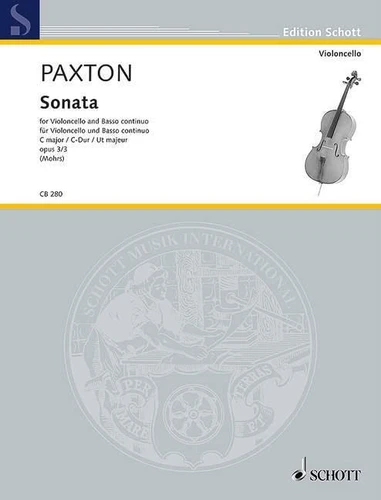Edition Schott
Sonata Ut majeur. op. 3/3. cello and basso continuo.
Par : Formats :
- Paiement en ligne :
- Livraison à domicile ou en point Mondial Relay indisponible
- Retrait Click and Collect en magasin gratuit
- Réservation en ligne avec paiement en magasin :
- Indisponible pour réserver et payer en magasin
- Nombre de pages20
- Poids0.103 kg
- Dimensions23,1 cm × 30,3 cm × 0,0 cm
- ISBN979-0-001-20299-2
- EAN9790001202992
- Date de parution01/01/2015
- CollectionCello Library
- ÉditeurSchott
Résumé
Stephen Paxton was one of the most important English composers for the cello in the transitional period between the Baroque and Classical eras. As the cello repertoire does not feature many very early Classical works his Sonatas op. 3, written for amateur cellists and students, fill a significant gap in tuition repertoire. This three-movement Sonata op. 3/3 is very well suited to the cello and distinguished by its elegant and appealing melodies.
The sonata can be played using the first four finger positions. As a cellist Paxton was very familiar with the technical capabilities of his instrument and knew how to make it sing with simple and effective figures. The first movement consists of two sections and has an expressive middle section in C minor. The slow movement uses an Irish folk song ('Gramachree'), with two dance movements (Minuet 1 and 2) at the end.
This new edition reproduces all the details of the first printed version, with just a few dynamic markings added in square brackets. The bass part has been written out in the style of an early Classical keyboard accompaniment so as to underline the galant rococo style of the piece. Instrumentation : cello and basso continuo op. 3/3
The sonata can be played using the first four finger positions. As a cellist Paxton was very familiar with the technical capabilities of his instrument and knew how to make it sing with simple and effective figures. The first movement consists of two sections and has an expressive middle section in C minor. The slow movement uses an Irish folk song ('Gramachree'), with two dance movements (Minuet 1 and 2) at the end.
This new edition reproduces all the details of the first printed version, with just a few dynamic markings added in square brackets. The bass part has been written out in the style of an early Classical keyboard accompaniment so as to underline the galant rococo style of the piece. Instrumentation : cello and basso continuo op. 3/3
Stephen Paxton was one of the most important English composers for the cello in the transitional period between the Baroque and Classical eras. As the cello repertoire does not feature many very early Classical works his Sonatas op. 3, written for amateur cellists and students, fill a significant gap in tuition repertoire. This three-movement Sonata op. 3/3 is very well suited to the cello and distinguished by its elegant and appealing melodies.
The sonata can be played using the first four finger positions. As a cellist Paxton was very familiar with the technical capabilities of his instrument and knew how to make it sing with simple and effective figures. The first movement consists of two sections and has an expressive middle section in C minor. The slow movement uses an Irish folk song ('Gramachree'), with two dance movements (Minuet 1 and 2) at the end.
This new edition reproduces all the details of the first printed version, with just a few dynamic markings added in square brackets. The bass part has been written out in the style of an early Classical keyboard accompaniment so as to underline the galant rococo style of the piece. Instrumentation : cello and basso continuo op. 3/3
The sonata can be played using the first four finger positions. As a cellist Paxton was very familiar with the technical capabilities of his instrument and knew how to make it sing with simple and effective figures. The first movement consists of two sections and has an expressive middle section in C minor. The slow movement uses an Irish folk song ('Gramachree'), with two dance movements (Minuet 1 and 2) at the end.
This new edition reproduces all the details of the first printed version, with just a few dynamic markings added in square brackets. The bass part has been written out in the style of an early Classical keyboard accompaniment so as to underline the galant rococo style of the piece. Instrumentation : cello and basso continuo op. 3/3

